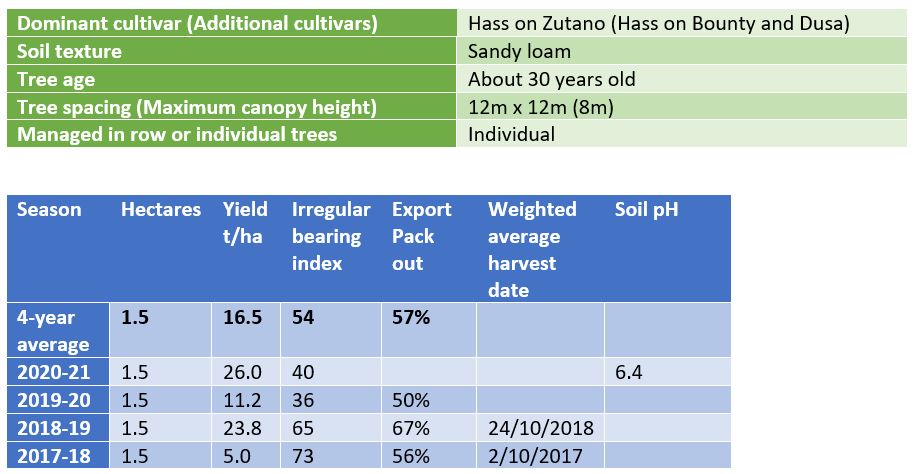Most positive influence on orchard performance
- Biggest positive influence is probably the soil. Land was a market garden after World War 2 then kiwifruit and planted in avocados around 1990. Have seen positive result of applying 10t/ha of compost a year for the last few years.
Most negative influence on orchard performance
- Wind is the biggest negative from the West and North East. Harvest is generally good if strong westerlies stay away.
General management
- Pollination, pruning and fertiliser planning, pest monitoring and spraying is contracted out. Remainder of work is completed by owners. Low pruning is done by owners.
- Have pruned up skirts of trees to help wind blow through orchard as trees used to act like sails and get blown over.
- Have planted Hass on Bounty on mounds at 4-5m spacing. Once they are cropping then height will be reduced more heavily on older part of orchard.
Canopy management
- Tree spaced 12m X 12m for older section and 4-5m spacing on new block.
- Max height of trees is 8m but working to get down to 6m with plan to keep new tree height to 5m.
- Structural tree balance is the main priority when pruning followed by light interception, increased access for picking and spraying, removal of dead or diseased material and management of crop load.
- Trees are structurally pruned once a year with larger cuts made in winter. About 20% of the canopy is removed each year.
- Flower pruning or fruitlet removal is not carried out.
Soil and soil moisture management
- Orchard is predominately sandy loam.
- Leaf litter and mulch is the dominant ground cover under trees with some avocado and shelter pruning making up the mulch.
- Soil moisture is not monitored.
- The orchard is 100% irrigated with in-canopy micro sprinklers.
- At peak summer it is common to irrigate for 4 hours per irrigation event once a week using sprinklers with a 10m diameter that deliver 106l/hr (5.4mm per irrigation event).
- Sprinkler heads that distribute different volumes over different area are chosen based on tree size and age.
- The condition of pipe work and control valves has been checked in the last year for proper function. Sprinklers heads are monitored regularly.
Pollination
- Pollinizer species include Bacon, Ettinger and Zutano at a percentage of more than 12%
- Honey bee and bumble bee hives are brought onto the orchard at about 5-10% flowering at a rate of 8-10 hives per hectare. Hives are placed equally in the blocks.
Soil and fertiliser application
- Soil and leaf tests are carried out once a year in May.
- A consultant provides a fertiliser plan based on test results and crop loading.
- The majority of fertiliser is applied as ground application by hand but foliar applications are also made.
- Boron and calcium fertilisers are applied as ground application every year.
- Fertiliser in some form is applied 10 times a year.
Shelter
- Cryptomeria and casurina trees make up all the shelters and are about 8m high on most boundaries.
Tree health management
Trees have injected with phosphonate once a year. Root testing of phosphonate levels are carried out each year.
Frost protection
No frost protection system is used in the orchard.

